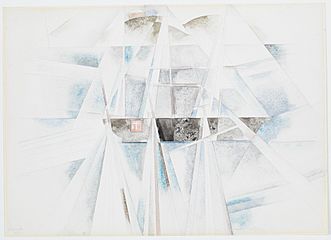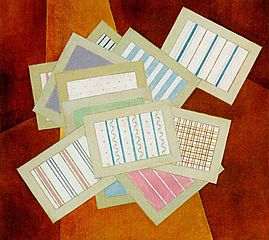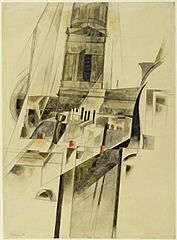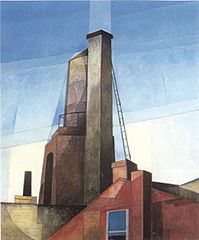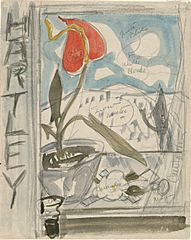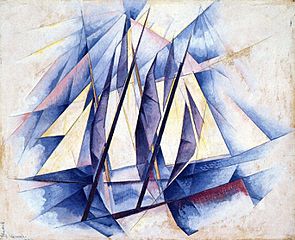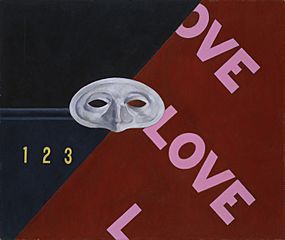Charles Demuth facts for kids
Quick facts for kids
Charles Demuth
|
|
|---|---|
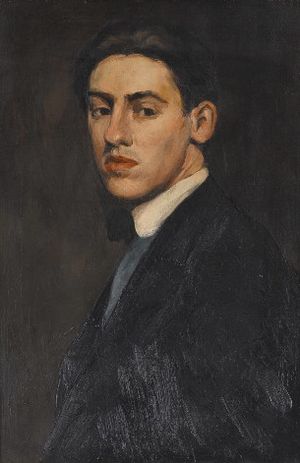
Self-Portrait, 1907
|
|
| Born | November 8, 1883 Lancaster, Pennsylvania, U.S.
|
| Died | October 23, 1935 (aged 51) Lancaster, Pennsylvania, U.S.
|
| Resting place | Lancaster Cemetery, Lancaster, Pennsylvania, U.S. |
| Education | Drexel University, Pennsylvania Academy of Fine Arts, Académie Colarossi, and Académie Julian |
| Known for | Watercolor, Painting |
| Movement | Precisionism |
Charles Henry Buckius Demuth (born November 8, 1883 – died October 23, 1935) was an American painter. He was famous for his amazing watercolor paintings. Later in his life, he also started using oils. He helped create a unique art style called Precisionism.
A famous art critic, Ken Johnson, once wrote that few watercolors are as beautiful as Demuth's. His paintings of flowers, fruits, and vegetables were full of life. They combined careful details of nature with a style called Cubism.
Demuth lived his whole life in Lancaster, Pennsylvania. His childhood home is now the Demuth Museum. This museum shows many of his artworks. He went to Franklin & Marshall Academy. Then he studied art at Drexel University and the Pennsylvania Academy of Fine Arts in Philadelphia. While studying there, he met the writer William Carlos Williams. They became very close friends for life.
He also studied art in Paris at the Académie Colarossi and Académie Julian. In Paris, he joined the avant-garde art scene. After returning to America, Demuth used parts of the Cubism style in many of his paintings.
Contents
Early Life and Art Beginnings
Charles Demuth was born on November 8, 1883, in Lancaster, Pennsylvania. In 1889, when he was six years old, his family moved to an old house built in the 1700s. This house was next to his family's tobacco shop, which had been open since 1770. Demuth lived in this house with his mother for the rest of his life. He had a small art studio on the second floor.
Demuth loved his hometown of Lancaster very much. He painted hundreds of watercolors and oils of the city's buildings. He showed warehouses, factories, and row houses in a grand way. For example, his painting of two grain silos, called My Egypt (1927), makes them look as grand as ancient pyramids. In 1907, he painted his first self-portrait using oil paints.
When Demuth was young, he had a leg injury or illness. This caused him to walk with a limp and use a cane. Later, he developed diabetes. He was one of the first people in the United States to receive insulin for his condition.
Developing His Art Style
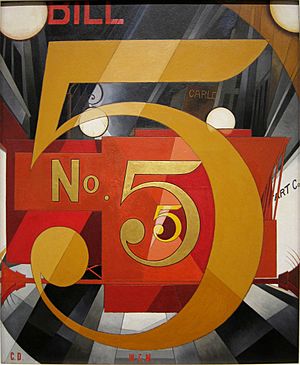
While in Paris, Demuth met another American artist, Marsden Hartley. Demuth had a great sense of humor. He quickly became part of a group of American artists. Through Hartley, he met Alfred Stieglitz, a very important person in American art. Demuth became part of Stieglitz's art group. In 1926, Demuth had his own art shows in New York City.
Demuth learned about modernism during his trips to Europe between 1907 and 1921. He often visited New York City. There, he saw new art styles and ideas, especially Cubism. The influence of Cubism can be seen in many of his artworks.
One of his most famous paintings is I Saw the Figure 5 in Gold. This painting was inspired by a poem called "The Great Figure" by his friend William Carlos Williams. The painting shows a fire engine speeding by in the rain. It uses numbers and shapes to represent the poem. This painting is considered a "poster portrait." It's a clever way to honor his friend, the poet. It also shows how American artists were creating their own styles.
I Saw the Figure 5 in Gold is one of 10 "poster portraits" Demuth planned to create. He wanted to honor his creative friends. He finished six of them, honoring Williams, Georgia O'Keeffe, Arthur Dove, Charles Duncan, John Marin, and Bert Savoy. These paintings showed his friends through objects and words, not just their faces.
Demuth, along with artists like Georgia O'Keeffe and Charles Sheeler, was a key artist in the Precisionist art movement. This movement started in America around 1915. Precisionist art often showed clear, sharp forms, almost like Cubism. Demuth's paintings often featured city and country scenes. These included industrial buildings like bridges, smokestacks, and skyscrapers. His painting "Aucassin and Nicolette" is a good example of Precisionist art. It shows a structured scene with no people, an industrial setting, and sharp, straight lines.
In 1919, Demuth began a series of paintings inspired by the buildings in Lancaster. For these works, he used oil and tempera paints instead of watercolors. These paintings were also larger than many of his other works. They mixed realism with abstract ideas. In 1927, he started a series of seven panel paintings showing factory buildings in his hometown. He finished the last one, After All, in 1933. These paintings helped establish his reputation as a major Precisionist painter.
Later Years and Passing
Demuth lived most of his life with delicate health. By 1920, his diabetes began to affect his energy for painting. He passed away at his home in Lancaster County, Pennsylvania, at the age of 51. He is buried in the Lancaster Cemetery.
Selected Works
See also
 In Spanish: Charles Demuth para niños
In Spanish: Charles Demuth para niños




